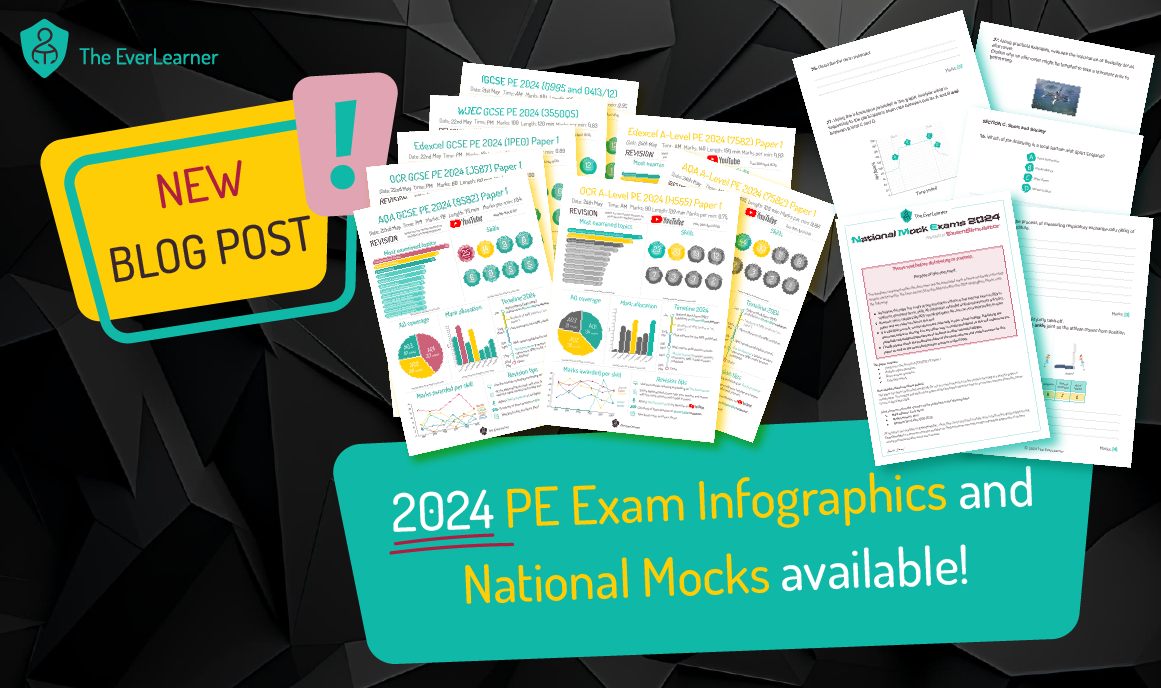We need to talk about PE mark schemes
Dear PE teachers
I’m nervous about writing this post, as it inevitably will be interpreted by some as critical. I always go very cautiously when publishing online and, typically, steer clear of any form of negativity or controversy. There’s enough of that in the world already and I don’t want to add more. However, I deem that this post is important enough to mean that I need to be honest with my opinions and try to influence change and growth.
What follows will include some criticism of past work by various exam boards. This is, in fact, the nature of this post but I want to be categorical and state that this post is not personal, nor partisan nor intended to do anything but cause improvements and clarity within our sector. I also want readers to be aware that I have provided this article to all named examination boards and, should I receive responses from any exam board post-publishing, I will publish them in full as part of this article. I hope this is fair.
So, what’s the issue? It is my contention that the quality and accuracy of many PE exam mark schemes are not sufficient to drive ever higher standards in our profession. To be clearer, I think we have the following issues across a range of exam board mark schemes which, in my opinion, too often:
- do not represent the skill that has been used within the question;
- do not provide sufficient rigour for questions that have contained an application to movement, health or sport;
- do not answer the question posed;
- do not fulfil the command word that has been used;
- do not sufficiently educate the reader/user of the mark scheme as to why some answers are correct and others not.
That feels pretty condemning now I have written it down. As you will well imagine, my points above do not apply to every mark scheme. Many questions and mark schemes are beautifully written. However, I am arguing that the points above occur too frequently for me to be comfortable with the rate of anomalies. Therefore, I intend to challenge them.
Examples
My aim in this section is to emphasise to you what I mean with examples without shaming anyone. Please take a look at these examples:
Example 1: The mark scheme does not represent the skill that has been used in the question
Question and mark scheme taken from Edexcel GCSE PE 9-1 Paper 1 2022

This question clearly requires the student to explain why the CV system contributes to thermoregulation during exercise, right? Wrong! Why? Because the mark scheme is 75% focussed on a description of thermoregulation:

Three out of four marks do not require the respondent to provide a reason. 75% of the marks do not involve an explanation at all. The only explanation in this mark scheme is “to prevent from overheating”. The other three marks are awarded despite them not answering the question posed. Furthermore, the very first point is very general. Does it mean work rate in terms of exercise intensity? If so, why is this key term not used? Is it suggesting that exercise is at a greater intensity than rest? Or, is it suggesting an increase in intensity during different phases of the exercise? If it is the latter, this is simply not true. The mark scheme should, in fact. Look more like this:
- In order to prevent overheating
- Because energy release cannot occur in very hot body conditions.
- In order to prevent the need for excessive sweating.
- Because this can cause rapid fluid loss and negatively impact performance, such as causing stroke volume to decrease.
I could go on but the point I want to make is that my four bullet points above answer the question posed because they are all reasons. The actual mark scheme has three descriptions and one reason only. Furthermore, in order to answer the original Edexcel question as it is posed, a student would need to leap beyond the remit of the Edexcel itself. For example, my second bullet point is above the Edexcel spec level but does answer the Edexcel question as it is posed.
Example 2: The mark scheme does not provide sufficient rigour for questions that have contained an application to movement, health or sport.
Question and mark scheme taken from AQA A-level PE Paper 1 Summer 2024

Look closely at the question above. It appears to require an understanding of diving, maybe trampolining and certainly good coaching practices. In fact, it requires none of these. The respondent simply needs to recall the list of ways of promoting positive transfer and simply to re-state the terms of the question. Let me show you what I mean:

This is the mark scheme for this question. In order for the student to achieve (AO3) point 1, say, all they need to do is remember that a way to cause positive transfer is to highlight similarities and then add the word “diver” into their response. For example, this sentence would have been marked correct:
“The coach needs to highlight the similarities between the dives so the diver is aware.”
If the application had been cricket or tennis or any other sport, all the respondent would need to do is change one word without changing the substance of the answer:
“The coach needs to highlight the similarities between the shots so the cricketer is aware.”
Given that this particular question provides access to three AO3 marks, supposedly the hardest marks to achieve, we need to consider whether we are happy with this level of rigour. I am not. This question and mark scheme needs to be capable of differentiating a respondent who knows and, specifically, can apply more than another respondent. In my opinion, it doesn’t.
Here’s a second example, this time from the 2024 International Baccalaureate Sport, Exercise and Health Sciences sample assessment materials:

This question should require a knowledge of the body’s response to hot and humid conditions when training, as training (as well as the heat and humidity) is part of the environment. It doesn’t:

The mark scheme above simply states what a human body’s likely response to hot and humid exercise conditions is. A four-mark answer needs absolutely zero understanding of physical training. Yet, the question clearly makes reference to training. This makes the rider statement irrelevant or, worse, a confusing element of the question. Furthermore, the IB SEHS –a course that I have great admiration for– is marketed as BOTH a pure science AND a sports, exercise and health course. One could argue that it is the gold standard of PE courses, yet the question and mark scheme above requires nothing but biological knowledge. The question could be changed many times over and the mark scheme would remain the same. For example:
A football match is organised in hot and humid conditions. Explain the body’s acute responses to the stresses caused by this environment.
Or:
An ultra-marathon is organised in hot and humid conditions. Explain the body’s acute responses to the stresses caused by this environment.
I am asking you, the reader, what is the point of the application in this question, especially given that, again, four AO3 marks (the most challenging assessment skills of the course) are to be credited. IB, to their credit, really promote the importance of high-quality applications in all of their publications, even dedicating an entire page (page 18 if you’re interested) of the specification to it. The intent is great! The realisation, thus far, is not.
Example 3: The mark scheme does not answer the question posed
Question and mark scheme taken from OCR GCSE PE 9-1 Paper 2 2023

The question above feels like a really nice, accessible question for students to have a go at. The issue I perceive, however, is that the question specifically asks about improving performance. Therefore, any correct answers must address this. If not, answers of very different qualities and those not including reference to improvement could be marked equally.
Take a look at the mark scheme:

The mark scheme does not require any reference whatsoever to improving performance. Even the qualifying descriptors in bold to the right, don’t achieve this. To emphasise my point, I am going to provide you with two different answers both of which, according to this mark scheme, would be worthy of one mark:
- Answer 1: “A high jumper tells themselves that they are going to clear the bar before their approach.”
- Answer 2: “A high jumper has a greater chance of striking the track with greater conviction and take-off force because they have visualised a successful strike prior to their approach.”
Only answer 2 answers the question posed because it has a performance impact. Answer 1 is generic and does not contain any reference to performance impact but both would be awarded one mark.
Some readers will argue that I am being harsh and expecting too much from GCSE PE students. My answer to you is this simple: why ask that question if we do not expect students to answer that question? The mark scheme does not answer the question. That is simply not good enough.
Example 4: The mark scheme does not fulfil the command word that has been used
Question and mark scheme taken from WJEC GCSE PE Full Course 2023
Take a look at question 1(d) from the 2023 WJEC paper:

Now take a look at what WJEC themselves tell us that evaluating is:

WJEC clearly state that to evaluate is to weigh up points for and against. So, one would assume that a candidate answering our PE question would need to weigh up BOTH the positives and the negatives about long-term exercise and mental and social health. However, here’s the indicative content:

And here are the level descriptors:

There is no reference to the need to evaluate at all. Think of all the students that wracked their brains trying to think about a negative social consequence of long-term training on a person. I bet students wrote about parents being at the gym and not at home or about couples that didn’t spend enough time together. The same could be said of the mental side: students probably tried to write about people too obsessed with training and health. Well, none of this was relevant because the mark scheme did not match the evaluate command.
Now look at what WJEC consider an ‘Analyse’ command to mean:

Clearly, our PE question above should have used the analyse command if the mark scheme was to remain as it is. Analysing leaves the space for some advantages and disadvantages as you can read in the descriptor but it clearly reflects the mark scheme that has been provided because it focuses on breaking a concept (health) into parts (mental and social health) and explaining each one.
I often wonder with these examples whether question writers or their colleagues simply switch commands in order to provide the correct representation of skills or assessment objectives. Could it be that our question above was originally an ‘Analyse’ command and then, based on the balance of the paper, was simply switched to the ‘Evaluate’ command without the onerous work of changing the mark scheme? We will never know this but it would, at least, explain the anomaly.
Example 5: The mark scheme does not sufficiently educate the reader/user as to why some answers are correct and others are not.
Question and mark scheme taken from Cambridge Nationals in Sport Studies R184 Exam Paper January 2024
Take a look at what appears to be a nice, straightforward question about etiquette:

The questions seem well written and three marks seem to be appropriately available for knowledgeable students who are able to apply their knowledge. Well, that’s what should be the case. Take a look at the mark scheme:

6a seems reasonable. I feel it should have been a ‘Define’ command but I am happy to accept that the mark scheme reflects the “Describe the term…” structure. 6b is a whole other story. Take a look at the right-hand column. It states: “DNA (Do Not Accept) - Examples of sportsmanship.” I challenge any PE teacher reading this article to name one single act of etiquette that is not also an act of sportsmanship. Go on, give it a try. Look at mark scheme point 3: Walking in cricket appears not to be an act of sportsmanship. Really? The same applies to point 4 for table tennis. If I, a PE teacher of 27 years experience, am struggling to understand what is etiquette and what is sportsmanship based on the information above, how on earth is a 16-year-old student meant to reliably understand the requirements of the question and display their knowledge? Please, note: OCR has not provided any guidance as to what the distinction is between etiquette and sportsmanship.
Furthermore, notice that some of the examples that are provided as correct are definitely not acts of etiquette. Point 2 states: “Remaining quiet during an opponent’s serve (in tennis)” is an act of etiquette. No. This is sticking to the rules or, technically, not fouling. The same goes with point 6. Imagine a golf commentator making this statement: “What great etiquette from the player. She didn’t deliberately make noise in order to distract her opponent whilst playing her shot.” Obviously, this is not etiquette.
If I were to speak to the question writer or lead examiner in this case, I would ask them to educate a little more via their mark schemes. If they don’t do this, students and teachers and markers are left trying to figure out the “figure-out-what-I’m-thinking” question. In other words, simply trying to play the game of what an examiner seems to want you to write rather than simply answering a question.
By way of an example of what is possible, take a look at an example of a question and mark scheme with guidance written by me.

This question featured on my 2024 National Mock Exam for Cambridge Nationals in Sport Studies R184.
Look at my mark scheme and, specifically, the guidance:

The expectations of students, teachers and markers are clear. This mark scheme and, specifically, the guidance clearly educate the reader. Exam boards could be far, far better at this.
Conclusions
You know what? I’m not sure what conclusions I draw from this post. I would like to conclude with some solutions or suggestions but, having written the post (this week’s has turned into a bit of a monster), it’s left me a bit deflated. I would like to reach out to all the exam boards and offer support. I would like to put my hat in the ring, even on a completely non-commercial basis, to help and offer guidance. I want to ask the exam boards to open up and acknowledge these challenges. I promise every exam board representative who may read this that writing world-class PE questions and mark schemes is absolutely possible.
More than anything, I want to finish here: PE teachers must never accept that their PE exams are structured in order to measure student performance in terms of how well they know the specific exam requirements. PE exams must contain very, very challenging questions that are clear and obvious in terms of what they are asking of students. I actually think that, with clearer questions and mark schemes, we could make the rigour of the average PE exam question far higher. Unfortunately, right now, too many PE exam questions and mark schemes are not fully considered and this leads to negative experiences for students and the threat of disillusionment from teachers.
Thanks for reading. I hope you have found my observations fair. Please let me know either way.
James
%20Text%20(Violet).png)


